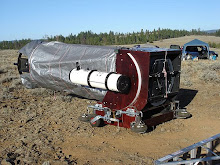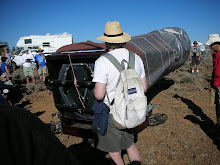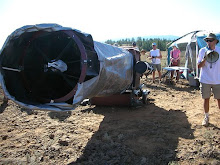

Six years since its maiden voyage, the adventure and monkeying with the monster continues. While I take the beast out only twice a year, its for ten days at a time in prime locations including the Oregon Star Party (Summer) and solo ventures to Death Valley California (Spring). The payoff is amazing - sparkler views of mid distance galaxy clusters (Virgo Cluster and the Perseus-Pisces Super cluster 250M LY out) and crazy views of more distant clusters (Hercules Cluster 500M LY out). These objects are true playgrounds to poke around for hours on an orchard ladder. The galaxies have perceivable shapes which coalesce remarkably over extended eyepiece time, and identifying each galaxy in these large groups using a sky safari map, on a wireless Ipad harnessed to my chest, is just super cool. Gravitational Lensing has been a special interest, but as of yet no luck in the galaxy cluster department.
Deepest yet has been the infamous Einstein's Cross... so gravitational lensing is not a total shutout with the monster. There's a lot of buzz on the web about this thing, and one can convince oneself that they are seeing it just to be done with it. A couple of years back I'm sure I got it - but only with an independently confirmed view of a second observer - Father William Holtzinger. 8ishB Light Years away and 17th magnitude (really? seemed dimmer!), We had to double barlow to a magnification of 600X. The galaxy would sweep across in less then 10 seconds. Swapping views off a 16 ft orchard ladder was an athletes feat (feet?) and required several attempts, but Bill's astro cat moves and strategic timing for the Cross session (Az movement only - about 1am in August) made the difference. The Cross is pretty much a gimmic object but those photons are older then any other matter around us!
Over the years several modifications have been made to the monster to ease logistics and improve optical performance.
 Logistics - A Harbor Freight trailer dolly, boat winch, and three ramps under a sheet of 3/4" plywood (I use to use two ramps until one failed under load and I almost lost the monster) are augmented by a weird 2x6 lever system and enable one person setup of the half ton contraption. Its still scary, and one could get hurt, so I've learned to go slow and keep thinking all the way through. I don't tear down in the dark any more after a few early morning misadventures.
Logistics - A Harbor Freight trailer dolly, boat winch, and three ramps under a sheet of 3/4" plywood (I use to use two ramps until one failed under load and I almost lost the monster) are augmented by a weird 2x6 lever system and enable one person setup of the half ton contraption. Its still scary, and one could get hurt, so I've learned to go slow and keep thinking all the way through. I don't tear down in the dark any more after a few early morning misadventures. 
.jpeg) |
| Andrew Cooper Can take a pic eh? |
To get to the eyepiece I made a very cool mod to a custom (double the rungs) 16ft orchard ladder. It has retractable pneumatic wheels (Harbor Freight again) and a triangle truss to the third leg to enable pushing and pulling it to just the right spot. The truss lays the ladder off angle slightly more then an apple picker would go for - the observer can sit/lay/hook a cheek in the ladder for better comfort. $500 well spent!
Optical Mods in rank order of effectiveness
 1) Filter slider. No matter the size of the scope you must do this. I rigged a little lever under the eyepiece to enable easy sliding for-aft, putting a O3, UHC, and H Beta in the optical path. What I did not anticipate is what the brain can do when quickly swapping filters - dust lanes and nebula in galaxies pop. Closer to home, I do not think I could ever see the central star of the ring nebula without this trick. Funny thing about the ring - nobody ever wants to see the nebula, just the silly star in the middle!
1) Filter slider. No matter the size of the scope you must do this. I rigged a little lever under the eyepiece to enable easy sliding for-aft, putting a O3, UHC, and H Beta in the optical path. What I did not anticipate is what the brain can do when quickly swapping filters - dust lanes and nebula in galaxies pop. Closer to home, I do not think I could ever see the central star of the ring nebula without this trick. Funny thing about the ring - nobody ever wants to see the nebula, just the silly star in the middle!2) String Telescope Truss. Dan Gray invented this trick a decade ago. I tweeked the idea by putting my scope's full truss in tension with some seriously stout ratcheting cargo straps. Technically, I am putting the truss to a near buckling condition by carefully ratcheting the cage twords the mirror box one tick at a time. Laser alignment is maintained regardless of altitude. Gotta be careful about the ticks.... See the yellow straps in the pics
3) Black paint over everything shiny. This one is obvious. Unshrouded the scope loses a half magnitude.... I am dye-ing my painter tarps I arrange around the base of the scope black to cut down on light scatter. Maybe its psychological... but you see with your eyes and brain!
4) Laminar cross flow and mirror cooling. Odd plenums made of hot glued foam board squirt air across the mirror, fed by muffin fans attached with dryer hoses. First time I used it the scope sounded like a moose looking for company - it took me a few years to quiet it down and get it throttled down and truly laminar. I use a total 7 six inch fans, but the plenum fed cross flow is the game changer
.jpg) |
| altitude bearing mod |
 |
| az bearing mod |
I use urethane ball bearing wheels for altitude (from a material handling website), with adjustable Teflon brakes, and an at-the-eyepiece operated pneumatic Teflon brake (using a nylon air jack designed to wedge open car doors to enable a slim jim access) to fine tune motion in altitude.
3 sets of 10 in line skate bearings roll on a pricey stainless steel ring handle the azimuth axis, and a pair of plastic covered machine levelers fine tune the azimuth friction.
A two day dust storm in Eureka Valley California in Spring 2013 gave me the excuse to do the necessary surgery to make these mods. The half ton scope moves easily with one finger
6) Cup holders at the eyepiece. Not for coffee or beer - but for eyepieces. Yes its heavy but so is the scope - I put a 41mm panoptic, a 21mm ethos, and two barlows up there and I don't drop stuff. That's 20 lbs and almost $2000 of cargo!
 |
| Monster makes it in a Japanese Astro Mag |
Next Steps
Two words - Rancho Hildago! I'm gonna pay Gene Turner a visit in Feb 2014. There are big portable telescopes everywhere and there are old astronomers everywhere. But there are few big portable telescopes used by old astronomers. So I got a plan....
My sincere thanks to Mel Bartels, Richard Berry and Dan Gray for the help and encouragement through the years.
 |
| An aging well amateur astronomer |










